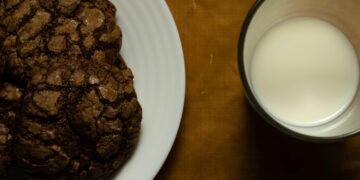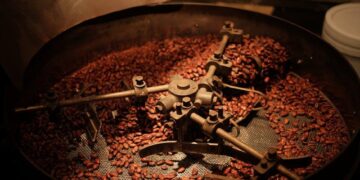Table of Contents
Part I: The Agonizing Question – When a Beloved Ritual Becomes a Source of Pain
Section 1.1: Introduction: My Coffee Crossroad
As a medical researcher, my world is built on data, evidence, and the systematic pursuit of answers.
But I am also a lifelong coffee lover.
For me, the morning ritual has always been sacred—the aroma of freshly ground beans, the warmth of the mug, the quiet focus it brings to the start of a new day.
It was more than a habit; it was a cornerstone of my identity.
Then, insidiously, my beloved ritual began to betray me.
It started subtly: a faint burning sensation in my chest after my second cup, a feeling I initially dismissed as indigestion.1
But soon, the symptoms became undeniable and impossible to ignore.
The burn intensified into full-blown heartburn, a searing discomfort that could last for hours.2
I began experiencing regurgitation, the unpleasant sour backwash of stomach acid into my throat.3
A persistent cough developed, particularly at night, and I often felt a strange sensation of a lump in my throat, a condition known as globus sensation.1
My professional training left no doubt about the diagnosis: Gastroesophageal Reflux Disease, or GERD.2
My body’s own digestive system was turning against a simple pleasure.
The lower esophageal sphincter (LES), the muscular valve that should keep stomach contents where they belong, was failing its duty, allowing acid to reflux into my esophagus.4
My initial response was to apply the standard, textbook advice I’d give to any patient.
I tried adding milk to my coffee, hoping the dairy would neutralize the acid.5
I made sure never to drink it on an empty stomach, always pairing it with food to “cushion” the impact.6
I even switched to decaf, suspecting caffeine might be the primary culprit.8
Yet, the relief was minimal and fleeting.
The pain persisted, a daily thief stealing a cherished part of my life.
This led me to a frustrating crossroad, forcing me to ask a question born not just of academic curiosity, but of personal desperation: Was there a way to keep coffee in my life without the suffering?
Section 1.2: The Myth and the Muddle: Entering the Cold Brew Maze
In my search for an answer, one phrase appeared again and again, presented as a panacea for coffee lovers with sensitive stomachs: cold brew.
The marketing claims were bold and alluring.
Enthusiasts and brands alike touted it as the definitive solution, a coffee that was fundamentally gentler and smoother.9
The most compelling claim, repeated across countless articles and product labels, was that cold brew contained significantly less acid—with some sources claiming a reduction of up to 67% or 70% compared to its hot-brewed counterpart.7
For someone in my position, this felt less like a product feature and more like a lifeline.
Hopeful, I turned to the scientific literature, expecting to find clear data supporting this widespread belief.
As a researcher, my first instinct is always to verify claims with empirical evidence.
What I found, however, was not clarity but confusion.
I was shocked to discover a series of studies, most notably from researchers Niny Rao and Megan Fuller at Thomas Jefferson University, that seemed to directly contradict the marketing hype.
Their research consistently found that the pH of cold brew and hot brew coffee samples were “comparable”.12
Both brewing methods produced coffee that fell within a very narrow pH range, typically between 4.85 and 5.13.14
This created a jarring paradox.
How could cold brew feel so much smoother and be perceived as so much less acidic if its pH value was virtually identical to hot coffee? It didn’t make sense.
The subjective experience of millions of drinkers and the objective measurements from the lab were in direct conflict.
This disconnect between popular perception, personal sensation, and the initial scientific data became the central mystery of my investigation.
I was determined to find out why—to unravel the science behind the cold brew paradox and find a definitive answer.
Part II: The Investigation – Unraveling the Science of Acidity
Section 2.1: Clue #1: The Red Herring of pH
My first step in solving the paradox was to critically examine the primary metric that was causing so much confusion: pH.
In chemistry, pH is a logarithmic scale used to specify the acidity or basicity of an aqueous solution.
It measures the concentration of free hydrogen ions (H+).12
A lower pH indicates a higher concentration of these ions and thus a more intensely acidic solution.
However, as I delved deeper, I realized that for a complex beverage like coffee, relying solely on pH is a critical oversimplification.
The fundamental issue is that pH measures only the intensity of acidity, not the quantity of acids present.
This is a crucial distinction.
A beverage can have a relatively high total amount of acid compounds but a moderate pH if those acids are “weak” and do not fully dissociate to release all their hydrogen ions into the solution.
This is precisely the case with coffee, which contains over 30 different organic acids, including chlorogenic, citric, malic, and quinic acids.9
Many of these are weak acids.
Therefore, pH provides an incomplete snapshot of the coffee’s total acid load, which is what our taste buds and stomachs ultimately react to.16
To make sense of this, it’s helpful to use an analogy: Pitch vs. Volume.
Imagine two different musical instruments, a flute and a pipe organ, both playing the exact same note—Middle C.
The pitch of the note is identical for both.
This is analogous to pH.
It’s a specific, fixed value.
However, the flute might be playing it as a soft, gentle whisper, while the pipe organ is playing it as a deafening, wall-shaking blast.
The volume, or amplitude, is dramatically different.
This “volume” is the crucial piece of information that pitch alone fails to capture.
In the world of coffee acidity, the “volume” is a different metric entirely, one that measures the total quantity of acid in the cup.
Section 2.2: Clue #2: Titratable Acidity – The Real Culprit
The search for coffee’s “volume” of acidity led me to a more revealing metric: titratable acidity.
In simple terms, while pH measures the concentration of free hydrogen ions at a single point in time, titratable acidity measures the total concentration of all acidic compounds in the coffee that can react with a base.
It is a measure of the coffee’s total acid reservoir, which correlates much more closely with the sensory perception of sourness or sharpness on the palate.13
This was the “aha!” moment in my investigation.
I went back to the very same studies by Rao and Fuller that had initially confused me with their pH findings.
Buried within their results was the key to the paradox.
While the pH values were comparable, their research consistently showed that hot-brewed coffee had significantly higher concentrations of total titratable acids than its cold-brewed counterparts.13
This was the breakthrough.
The coffee was chemically different in a way that directly explained the difference in taste and feel, but pH was simply the wrong tool for the job.
It was like trying to measure the weight of an object with a thermometer.
The reason cold brew tastes and feels gentler is because it literally contains a lower total quantity of acidic compounds.
The “volume” of its acidity is lower, even if the “pitch” is similar to hot brew.
This discovery resolved the first major contradiction and set me on the path to understanding why this difference occurs at a chemical level.
Section 2.3: Clue #3: The Chemistry of Extraction – A Tale of Two Temperatures
Knowing that hot brew has a higher total acid load, the next logical question was: why? The answer lies in the fundamental chemistry of extraction, the process of dissolving soluble compounds from coffee grounds into water.18
In coffee brewing, temperature is the master variable that dictates not only the speed but also the nature of this process.20
Hot water, typically used at temperatures between 195°F and 205°F (90°C to 96°C), acts as a powerful and aggressive solvent.20
The high thermal energy causes molecules to vibrate rapidly, accelerating the rate at which soluble compounds like acids, oils, sugars, and caffeine are extracted from the grounds.21
But the heat does more than just speed things up; it actively changes the chemistry of the brew.
A major group of acids in coffee, known as chlorogenic acids (CGAs), are particularly susceptible to heat.
At high temperatures, these CGAs degrade, breaking down into other compounds, primarily quinic acid and caffeic acid.24
These degradation byproducts are known to contribute a harsher, more astringent, and bitter taste to the final cup.24
Cold water, by contrast, is a much less efficient and more gentle solvent.18
At room temperature or colder, the extraction process is dramatically slower, taking hours instead of minutes.19
This slow, gentle persuasion is also more selective.
Cold water extracts fewer of the total acidic compounds and, crucially, lacks the thermal energy to trigger the degradation of CGAs.24
The delicate chemical structures of the acids are left largely intact, and the harsh-tasting byproducts associated with hot brewing are simply not created.
This reveals a profound distinction: hot brewing doesn’t just extract more acids; it creates a chemically different and more aggressive acid profile through thermal degradation.
Cold brewing, on the other hand, produces a cleaner profile that more closely resembles the original chemistry of the bean, resulting in a brew with lower total acidity and without the sharp, bitter notes born from high heat.
Section 2.4: The Smoking Gun – The Coffee Science Foundation Study
While the chemistry of extraction provided a strong theoretical framework, I needed definitive, controlled experimental data to confirm it.
I found it in a landmark, multi-year research project conducted by the UC Davis Coffee Center with support from the Coffee Science Foundation.26
This study addressed a critical flaw present in almost all casual comparisons of hot and cold brew: brew strength.
As the researchers pointed out, comparing a five-minute hot brew to a 24-hour cold brew concentrate is meaningless without controlling for the Total Dissolved Solids (TDS), which is a measure of the total amount of coffee solids dissolved in the water.26
A weak hot coffee will naturally have less of everything—acids, caffeine, flavor compounds—than a potent cold brew concentrate.
To make a true apples-to-apples comparison, the brews must be brought to the exact same strength.
The UC Davis team did precisely this.
They brewed coffees hot and cold until they reached equilibrium (the point where no more solids can be dissolved) and then carefully diluted both to a precise 2% TDS before conducting chemical and sensory analysis.
Their findings were the final, irrefutable pieces of the puzzle.
When compared at the exact same strength and serving temperature, cold brew was:
- Chemically and Measurably Less Acidic: The study found that cold brews consistently had a higher pH than their hot-brewed counterparts by 0.1 to 0.2 units.26 While a small difference, it was statistically significant and directly supported the lower-acidity claim under controlled conditions.
- Sensorially Smoother and Less Harsh: The sensory panel results were even more dramatic. Trained tasters found the cold brew samples to be statistically significantly less bitter, less sour, and less “rubbery” than the chilled hot brews. At the same time, the cold brews were rated as being more “floral”.26
This study provided the objective, scientific validation for the subjective experience of millions.
It proved that the gentleness of cold brew is not a placebo effect or a marketing gimmick.
It is a real, measurable phenomenon rooted in the fundamental chemistry of low-temperature extraction.
The paradox was solved.
Part III: The Revelation – Solving the Cold Brew Paradox
Section 3.1: The Answer Unveiled: A Different Chemical Fingerprint
The journey through the scientific literature, from the confusing pH data to the definitive UC Davis study, finally brought clarity.
The reason cold brew is gentler on the palate and stomach is not because its pH is drastically different in a casual measurement, but because it possesses a fundamentally different and less aggressive “chemical fingerprint.” This unique profile is the direct result of low-temperature extraction.
Synthesizing all the clues from the investigation, the solution to the cold brew paradox can be summarized by four key distinctions:
- Lower Total Acid Content: Cold brew contains a lower overall quantity of acidic compounds, a difference that is accurately captured by measuring titratable acidity, not pH.13
- A Different Acid Profile: Hot brewing uses high temperatures that chemically degrade chlorogenic acids into harsher-tasting quinic and caffeic acids. Cold brewing avoids this thermal degradation, resulting in a cleaner, less astringent acid profile.24
- Fewer Bitter Compounds: The aggressive nature of hot water extracts more bitter-tasting compounds and oils from the coffee bean, whereas cold water’s gentle extraction leaves more of them behind, contributing to a smoother taste.24
- A Demonstrably Smoother Sensory Experience: When all other variables are controlled, scientific sensory analysis confirms that cold brew is perceived as less sour and less bitter than hot brew prepared from the same beans.26
The following table consolidates these complex findings into a clear, comparative summary, providing a definitive answer to the question that started this journey.
Table 1: Hot Brew vs. Cold Brew – A Comparative Chemical & Sensory Profile
| Feature | Hot Brew | Cold Brew (at equivalent strength) |
| Brewing Temperature | High (195-205°F / 90-96°C) 20 | Low (Room temperature or chilled) 27 |
| pH Range | ~4.85 – 5.13 (Comparable to cold brew in many studies) 12 | ~4.85 – 5.13 (Can be 0.1-0.2 units higher under controlled conditions) 26 |
| Titratable Acidity | Higher (Greater total quantity of acidic compounds) 13 | Lower (Lesser total quantity of acidic compounds) 13 |
| Key Acidic Compounds | Higher levels of extracted acids; contains thermally degraded byproducts like quinic and caffeic acid 24 | Lower levels of extracted acids; acids remain chemically intact without heat-induced degradation 24 |
| Antioxidant Activity | Generally Higher, as heat extracts more antioxidant compounds 14 | Generally Lower, though still a significant source 14 |
| Perceived Bitterness | Higher 26 | Lower 26 |
| Perceived Sourness | Higher 26 | Lower 26 |
| Dominant Flavor Profile | More aromatic, complex, bright, lively acidity 24 | Smoother, mellow, rounder, more floral/chocolatey notes 24 |
Section 3.2: The Health Connection, Clarified: It’s Not Just “Acid”
Armed with this comprehensive understanding of coffee chemistry, I could finally revisit my personal struggle with GERD with new clarity.
The problem, I now understood, was more nuanced than simply “acid.” For individuals with acid reflux or sensitive stomachs, coffee presents a two-pronged challenge, and addressing only one is often insufficient.
The first trigger is, of course, the acidity profile.
As established, the higher total acid load (titratable acidity) and the presence of harsh, heat-degraded compounds in hot brew can directly irritate the stomach lining and esophagus.3
The second, and equally important, trigger is caffeine.
Independent of its acidity, caffeine itself can exacerbate GERD symptoms in two ways.
First, it can cause the lower esophageal sphincter (LES) to relax, making it easier for stomach acid to flow back into the esophagus.4
Second, caffeine can stimulate the stomach to produce more gastric acid, increasing the volume of acid available to cause irritation.5
This explains why simply switching to a “low acid” hot coffee or even decaf might not be a complete solution for everyone.
A person might be more sensitive to the caffeine’s effect on the LES, while another might be more sensitive to the chemical composition of the acids.
The evidence on coffee and GERD is often conflicting precisely because of this high degree of individual variability; what works for one person may not work for another.29
Cold brew offers a potential advantage because it can address both fronts simultaneously.
It has a demonstrably gentler acid profile, and while it can be high in caffeine, the concentration is highly controllable through the coffee-to-water ratio and steep time.25
This realization shifted my approach from seeking a single “magic bullet” solution to developing a holistic management strategy.
The goal is not just to find one “right” coffee but to understand the variables and empower oneself to conduct a personal experiment (an N-of-1 trial) to find the perfect balance of roast, brew method, and additives that works for their unique physiology.
Part IV: The Practical Field Guide to a Stomach-Friendly Brew
This final part of the investigation moves from the “why” to the “how.” It is the practical toolkit I developed through my research and personal experimentation to bring coffee back into my life without pain.
This is a guide to becoming your own coffee architect, empowering you to design a brew that fits both your palate and your body.
Section 4.1: Foundational Choices: Bean and Roast
The journey to a gentler cup begins long before water ever touches the grounds.
The characteristics of the bean itself are the single most important factor.
- Roast Level: This is the most impactful choice you can make. The roasting process itself fundamentally alters the bean’s chemical composition. Darker roasts are consistently and significantly less acidic than lighter roasts.17 As the beans are roasted for longer and at higher temperatures, the acidic compounds, particularly chlorogenic acids, are literally burned off and degraded.17 Light roasts, while prized by connoisseurs for their bright, nuanced, and complex “acidity” (a flavor term), are the most chemically acidic and often the most problematic for sensitive stomachs.17 For a low-acid coffee, start with a French, Italian, or other dark roast.
- Geographic Origin and Altitude: Coffee beans grown at lower altitudes tend to be naturally lower in acid. The slower maturation process at high altitudes allows for the development of more complex acids.9 Look for beans from low-altitude regions like
Brazil, Sumatra, Mexico, or Indonesia for a naturally milder profile.34 High-altitude coffees from Kenya or Ethiopia, while delicious, are known for their pronounced, wine-like acidity.17 - Processing Method: The way the coffee cherry is processed after harvesting also affects acidity. “Natural” or “dry-processed” coffees, where the bean is dried inside the fruit, tend to have lower acidity and a fuller body compared to “washed” coffees, where the fruit is removed before drying.17
Section 4.2: The Brewing Method Matrix
Once you have selected your beans, the brewing method is the next critical lever to control.
- The Gold Standard: Cold Brew: As established throughout this report, cold brewing is the undisputed champion for producing the lowest-acidity coffee. The gentle, low-temperature extraction over 12-24 hours results in a smooth, mellow concentrate with up to 70% less acid than a comparable hot brew.7 To make it, simply combine coarse-ground coffee with cold, filtered water (a 1:8 ratio by weight is a good starting point), let it steep in the refrigerator for 12-24 hours, and then strain it through a fine-mesh sieve or filter.
- Optimizing Hot Brew Methods: If you prefer a hot cup, you can still take steps to mitigate acidity:
- Use a Coarser Grind: A coarser grind reduces the total surface area of the coffee, which slows down the extraction of all compounds, including acids. This is particularly effective for immersion methods like a French Press.31
- Control Water Temperature: Never use boiling water. Aim for a temperature within the ideal range of 195-205°F (90-96°C).20 Using water that is too hot can over-extract the harshest compounds.36
- Ensure Proper Brew Time (Avoid Under-extraction): This is a common point of confusion. A brew that is too short can actually taste more sour. This is because the bright, acidic compounds are among the first things to be extracted. The balancing sweetness and deeper flavors from sugars and oils take longer to dissolve. An under-extracted coffee is unbalanced, with the sour notes dominating.23 Follow the recommended brew time for your chosen method to achieve a balanced extraction.
Section 4.3: Additives and Tweaks: Separating Fact from Fiction
After brewing, certain additives can further help neutralize the final cup’s acidity.
- Effective Neutralizers:
- Milk, Cream, or Almond Milk: Dairy products contain calcium, which is alkaline and can help neutralize acid. Plant-based milks, especially almond milk, are often alkaline as well and serve a similar purpose, buffering the coffee and making it gentler on the stomach.5
- Chemical Interventions (Use with Extreme Caution):
- Baking Soda: A tiny pinch of baking soda (sodium bicarbonate) is a powerful alkaline agent that will effectively neutralize acid. However, it must be used sparingly, as too much will impart a soapy, salty taste. The fizzing reaction can also produce gas, which may be counterproductive for those with reflux.7
- Eggshells: The calcium carbonate in clean, crushed eggshells is alkaline and will neutralize acid if added to the grounds before brewing. While effective, this method is cumbersome and requires thorough cleaning of the shells to avoid any risk of contamination.7
- The Salt “Hack” – A Flavor Modifier, Not a Neutralizer: Adding a tiny pinch of salt to your coffee does not chemically neutralize the acid. Instead, it works on your palate. The sodium ions interfere with your taste receptors’ ability to perceive bitterness. By suppressing bitterness, the coffee can taste smoother and sweeter, which many people interpret as being less acidic.39
Section 4.4: Debunking Myths and Ineffective Strategies
The internet is filled with conflicting advice.
Based on the evidence, it’s crucial to clear up some common misconceptions.
- The Grind Size Myth: The idea that a finer grind reduces acidity is a misunderstanding of extraction dynamics. A finer grind dramatically increases the surface area of the coffee, which speeds up the extraction of all soluble compounds, acids included.38 While it can be used to balance a brew, it is not a reliable method for reducing total acidity and can easily lead to a bitter, over-extracted cup. For the goal of lowering acidity, a coarser grind is a safer and more logical choice.36
- “Iced Coffee” is NOT Cold Brew: This is a critical distinction. Standard iced coffee is simply hot-brewed coffee that has been chilled and poured over ice. This cooling process does absolutely nothing to change its original, more acidic chemical profile. Only coffee brewed with cold water from the start earns the “cold brew” name and its associated low-acidity benefits.37
- “Espresso is less acidic”: This statement is partially true but for the wrong reason. The espresso brewing method itself, with its high pressure and fast extraction, does not inherently reduce acidity. The reason espresso is often perceived as less acidic is that it is almost universally made with very dark-roasted beans, which, as we’ve established, are naturally much lower in acid than the lighter roasts used for other methods.17 The low acidity comes from the roast, not the machine.
The following table provides a master summary of these practical strategies, acting as a quick-reference guide to help you build your personalized plan for a stomach-friendly brew.
Table 2: The Ultimate Guide to Reducing Coffee’s Acidity
| Method | Mechanism of Action (The Science) | Estimated Effectiveness | Key Considerations / Downsides |
| Choose Dark Roast Beans | The roasting process burns off and degrades acidic compounds.17 | High | Alters flavor profile; less of the bright, fruity notes found in light roasts. |
| Choose Low-Altitude Beans | Beans from regions like Brazil or Sumatra naturally develop fewer acids.9 | Medium | Flavor profiles are typically nutty, chocolatey, and earthy rather than fruity or floral. |
| Brew Cold Brew | Low-temperature extraction is slow and gentle, extracting fewer acids and avoiding thermal degradation.25 | High | Requires 12-24 hours of advance preparation. |
| Use a Coarser Grind | Reduces surface area, slowing the rate of acid extraction.31 | Medium | Most effective for immersion methods like French Press; requires adjusting brew time. |
| Add Milk / Almond Milk | Calcium and alkaline properties neutralize acid in the final cup.31 | Medium | Alters the taste and texture of black coffee; adds calories. |
| Add a Pinch of Baking Soda | A strong alkaline agent that chemically neutralizes acid.7 | High | Can easily ruin the flavor if too much is used; fizzing may cause burping/discomfort. |
| Add a Pinch of Salt | Suppresses the perception of bitterness on the palate, making coffee taste smoother.39 | Low | Does not change the chemical acidity; only affects taste perception. |
| Use Paper Filters | Paper traps some of the oils and fine particles that can contribute to acidity and bitterness.11 | Low | A minor tweak, but can contribute to a cleaner-tasting cup. |
Part V: Conclusion – An Empowered and Pain-Free Cup
My journey began in a place of painful confusion, with a beloved daily ritual turning into a source of chronic discomfort.
The simple question, “Is cold brew less acidic?” led me down a rabbit hole of conflicting marketing claims, confusing scientific data, and well-intentioned but often ineffective folk wisdom.
The investigation that followed, however, transformed my understanding and, ultimately, my relationship with coffee.
The key revelation, the solution to the cold brew paradox, was not a simple yes or No. It was the discovery that we have been asking the wrong question and using the wrong metric.
The answer lies not in the simplistic measurement of pH, but in understanding the deeper “chemical fingerprint” created by the interplay of heat and time.
Cold brew’s gentleness is real and measurable, stemming from its lower total acid load and its lack of the harsh, heat-degraded compounds that give hot coffee its aggressive edge.
This knowledge is more than just academic; it is empowering.
It provides a clear, evidence-based roadmap for anyone who, like me, has struggled with coffee-related digestive issues.
We do not have to give up coffee.
By understanding the science—the critical roles of roast level, bean origin, brewing temperature, and extraction time—we can move from being passive victims of coffee’s side effects to becoming active architects of our own brew.
The ultimate takeaway is that you are in control.
You can now consciously select darker roasts from low-altitude regions, choose a gentle cold brew method, or fine-tune your hot brew with a coarser grind and the right additives.
You can build a cup of coffee that is perfectly tailored not just to your taste preferences, but to the unique needs of your body.
The journey from pain to empowerment ends here, with the knowledge and tools to enjoy every last drop, completely and wonderfully pain-free.
Works cited
- Acid Reflux & GERD: Symptoms, What It Is, Causes, Treatment – Cleveland Clinic, accessed August 2, 2025, https://my.clevelandclinic.org/health/diseases/17019-acid-reflux-gerd
- Gastroesophageal reflux disease (GERD) – Symptoms and causes – Mayo Clinic, accessed August 2, 2025, https://www.mayoclinic.org/diseases-conditions/gerd/symptoms-causes/syc-20361940
- Acid Reflux & Coffee: Understanding What It Means for You, accessed August 2, 2025, https://puroast.com/blogs/news/acid-reflux-coffee-understanding-what-it-means-for-you
- Are Coffee and Tea Off Limits? How Caffeine Affects GERD – Healthline, accessed August 2, 2025, https://www.healthline.com/health/gerd/coffee-tea
- Tips to Brew Coffee That Won’t Irritate Your Stomach – Verywell Health, accessed August 2, 2025, https://www.verywellhealth.com/coffee-that-wont-cause-stomach-upset-4146967
- Can Coffee Cause Heartburn? – Tums, accessed August 2, 2025, https://www.tums.com/about-heartburn/causes/can-coffee-cause-heartburn/
- How to Make Coffee Less Acidic (Without Ruining It) – Food Fanatic, accessed August 2, 2025, https://www.foodfanatic.com/cooking/how-to/how-to-make-coffee-less-acidic-without-ruining-it/
- How Coffee Lovers Manage Acid Reflux | Café Altura, accessed August 2, 2025, https://cafealtura.com/coffee-and-acid-reflux/
- Low Acid Coffee: Gentle on Your Stomach, Full of Flavor! – OutIn, accessed August 2, 2025, https://outin.com/blogs/news/low-acid-coffee-benefits
- Low Acid Coffee: How Does it Taste?, accessed August 2, 2025, https://puroast.com/blogs/news/low-acid-coffee-how-does-it-taste
- How to Decrease the Acidity of Coffee – 3 Strategies, accessed August 2, 2025, https://zavida.com/blogs/coffee-methods/how-to-decrease-the-acidity-of-coffee-3-strategies
- Is Cold Brew Coffee Less Acidic Than Hot Brew?, accessed August 2, 2025, https://fifty5rivers.com/journals/coldbrewcoffee/is-cold-brew-coffee-less-acidic-compared-to-hot-brew-coffee/
- Acidity and Antioxidant Activity of Cold Brew Coffee – PubMed, accessed August 2, 2025, https://pubmed.ncbi.nlm.nih.gov/30375458/
- Is Hot Coffee Better For You Than Cold Brew? | Sprudge Coffee, accessed August 2, 2025, https://sprudge.com/is-hot-coffee-better-for-you-than-cold-brew-138025.html
- Research Into Acidity and Antioxidants in Cold Brew vs. Hot Coffee Yields Surprising Results, accessed August 2, 2025, https://dailycoffeenews.com/2020/04/15/research-into-acidity-and-antioxidants-in-cold-brew-vs-hot-coffee-yields-surprising-results/
- The 101 on Coffee Acidity – RISE Brewing Co., accessed August 2, 2025, https://risebrewingco.com/blogs/on-the-rise/the-101-on-coffee-acidity
- Low Acid Coffee – Espresso & Coffee Guide, accessed August 2, 2025, https://espressocoffeeguide.com/low-acid-coffee/
- hardtank.com, accessed August 2, 2025, https://hardtank.com/2025/05/06/science-of-cold-brew-extraction/#:~:text=%E2%80%9CExtraction%20is%20fundamentally%20a%20process,as%20efficiently%20as%20hot%20water.
- How Does Cold Extraction Work? – Driftaway Coffee, accessed August 2, 2025, https://driftaway.coffee/how-does-cold-extraction-work/
- Why Does the Coffee Brewing Temperature Matter?, accessed August 2, 2025, https://www.sheldrakecoffeeroasting.com/blogs/the-sheldrake-coffee-blog/why-does-the-coffee-brewing-temperature-matter
- How Does Water Temperature Affect Coffee Extraction Efficiency?, accessed August 2, 2025, https://coffeemachinetools.com/how-does-water-temperature-affect-coffee-extraction-efficiency/
- Coffee Brewing and Ideal Water Temperature – Podium Coffee Club, accessed August 2, 2025, https://podiumcoffeeclub.com/blogs/blog/coffee-brewing-water-temperature
- Water temp in relation to extraction : r/Coffee – Reddit, accessed August 2, 2025, https://www.reddit.com/r/Coffee/comments/8nsw1j/water_temp_in_relation_to_extraction/
- The Chemistry of Cold Brew Coffee vs. Hot Brewed Coffee …, accessed August 2, 2025, https://espressooutlet.com/blogs/news/the-chemistry-of-cold-brew-coffee-vs-hot-brewed-coffee
- The Chemistry of Brewing Cold Brew Coffee: A Deep Dive, accessed August 2, 2025, https://torque.coffee/blogs/brew-guides/the-chemistry-of-brewing-cold-brew-coffee-a-deep-dive
- Worth the Wait: How Cold Brew Differs from Chilled Hot Brew | 25 …, accessed August 2, 2025, https://sca.coffee/sca-news/25/issue-22/how-cold-brew-differs-from-chilled-hot-brew
- Cold brew coffee – Wikipedia, accessed August 2, 2025, https://en.wikipedia.org/wiki/Cold_brew_coffee
- Variables Affecting the Extraction of Antioxidants in Cold and Hot Brew Coffee: A Review, accessed August 2, 2025, https://www.mdpi.com/2076-3921/13/1/29
- GERD and caffeine: Can you drink tea and coffee? – Medical News Today, accessed August 2, 2025, https://www.medicalnewstoday.com/articles/323333
- Effects of Coffee on the Gastro-Intestinal Tract: A Narrative Review and Literature Update, accessed August 2, 2025, https://pmc.ncbi.nlm.nih.gov/articles/PMC8778943/
- Sensitive Stomach? Here’s How to Find Low Acid Coffee, accessed August 2, 2025, https://peakstatecoffee.com/blogs/peak-state/sensitive-stomach-six-factors-of-acidity-in-coffee
- (PDF) Reducing Coffee Acidity and Caffeine through the Roasting Method using Azadirachtaindica Firewood – ResearchGate, accessed August 2, 2025, https://www.researchgate.net/publication/385784857_Reducing_Coffee_Acidity_and_Caffeine_through_the_Roasting_Method_using_Azadirachtaindica_Firewood
- What kinds of coffees would be best for someone who likes low acidity? – Reddit, accessed August 2, 2025, https://www.reddit.com/r/Coffee/comments/hizn69/what_kinds_of_coffees_would_be_best_for_someone/
- Is low-acid coffee legit or a marketing scam? – Reddit, accessed August 2, 2025, https://www.reddit.com/r/Coffee/comments/lyh5z0/is_lowacid_coffee_legit_or_a_marketing_scam/
- How to reduce acidic flavors in coffee – Breville, accessed August 2, 2025, https://www.breville.com/us/en/blog/coffee-and-espresso/how-to-reduce-acidic-flavors-in-coffee.html
- What’s LOW ACID COFFEE? Reduce Coffee Stomach Pain – YouTube, accessed August 2, 2025, https://www.youtube.com/watch?v=xTWsbOlHEiY
- 4 Burning Truths About Making Low Acid Coffee, accessed August 2, 2025, https://grumpygoat.com/4-burning-truths-about-low-acid-coffee/
- How Do You Reduce Acidity in Coffee? – MedicineNet, accessed August 2, 2025, https://www.medicinenet.com/how_do_you_reduce_acidity_in_coffee/article.htm
- How to Make Your Instant Coffee Less Acidic, accessed August 2, 2025, https://www.wakacoffee.com/blogs/coffeelifeblog/how-to-make-your-instant-coffee-less-acidic
- Innovative Ways to Reduce Coffee Acidity, accessed August 2, 2025, https://lifeboostcoffee.com/blogs/lifeboost/innovative-ways-to-reduce-coffee-acidity






